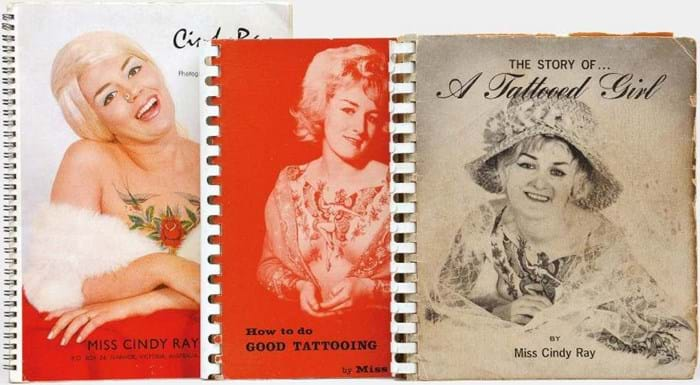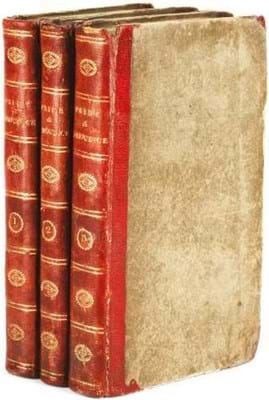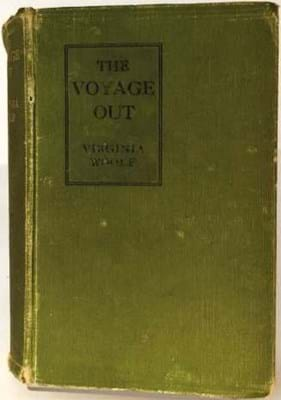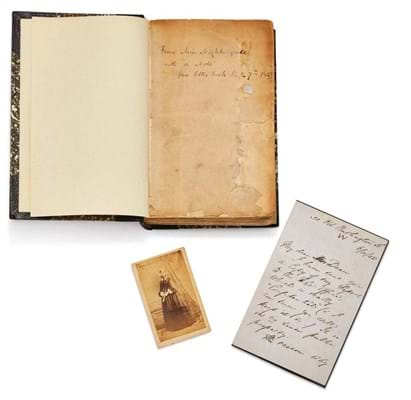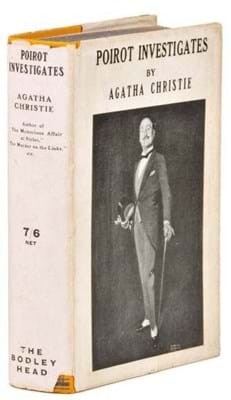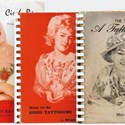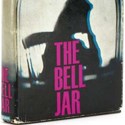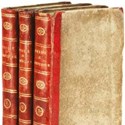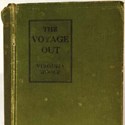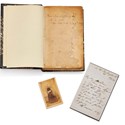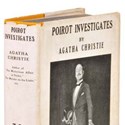In the last 12 months, books by women have become talk of the rare bookselling world. Myriad booksellers have turned their attention to women’s contributions to literature, history, science, travel, politics, and beyond. It is not a moment too soon.
Of course, books by women have always been collected alongside those by men. The Dutch academic Prof Alicia Montoya has recently analysed the auction catalogues of 250 Netherlandish libraries of the 18th century and found within them almost 600 titles by 200 different women writers. There have long been female collectors too. England’s first acknowledged female bibliophile, Frances Mary Richard Currer (1785-1861), owned a library of perhaps 20,000 volumes at Eshton Hall, Craven, Yorkshire. It included the many early printed rarities listed in a catalogue published in 1833 (one is available through Peter Harrington at £3000).
Contemporaries such as Thomas Frognall Dibdin, founder of the Roxburghe Club in 1812, judged that Currer’s library placed her ‘at the head of all female collectors in Europe’ − although he did not go so far as to invite her to join his society. It wasn’t until 1985 that American collector Mary Hyde Eccles became the first women to join the Roxburghe.
For decades the best-known female authors have commanded strong prices
For decades the best-known female authors have commanded strong prices. The origins of the market for the books of Jane Austen are found in the 1830s – first editions were much collected shortly after her death – and had soared in price in the bibliographic boom years before the Wall Street Crash.
In the legendary sale of the collection of Broadway composer Jerome Kern held by Anderson Galleries in New York in January 1929, Jane Austen was a top seller. So too Fanny Burney whose Evelina made almost the same as an autographed copy of the Kilmarnock Burns ($23,000).
To give just one more example, Kern had bought an autographed copy of Elizabeth Barrett Browning’s first published work, The Battle of Marathon, for $1650 at the beginning of the decade. It sold for $17,500 − more than anything by her husband Robert Browning and a sum that in real terms has never since been matched.
Redressing the balance
However, collecting with a distinct focus on women is probably a more recent phenomenon. American bibliophiles Lisa Unger Baskin and Caroline Schimmel began in the late 1960s followed by Chappaqua librarian Paula Peyraud and Cisco co-founder Sandy Lerner. The sale of Peyraud’s multimedia collection of works associated with Samuel Johnson and the 18th century ‘Bluestocking’ circle of writers dispersed by Bloomsbury New York in 2009 is unusual among auctions in having such a strong focus on books by women.
A new generation of female booksellers is energising the world of rare books
More recently universities and other research libraries – conscious that the male-dominated literary canon has been done to death − have done much to drive the growth in the market for women’s writing. The Baskin and Schimmel collections now form core sections of the Rubenstein and the Penn libraries respectively, but not all institutions have been the fortunate beneficiaries of bequests from early bird collectors. Many are playing catch-up.
From the recent Peter Harrington catalogue In Her Own Words: Works by Exceptional Women, assembled across a year-long project by specialists Theodora Robinson and Emma Walshe, more than 50% of the 179 items sold – perhaps half of them to institutional buyers. Perhaps one day we might have gender equality on the bookshelves of the finest libraries.
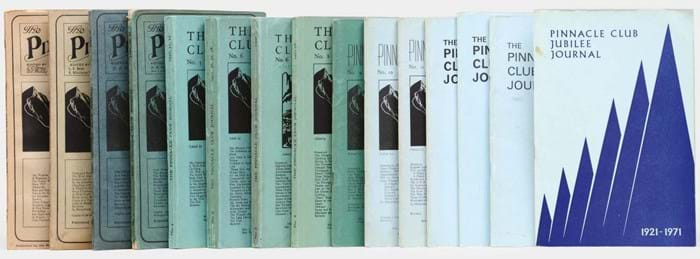
Among Theodora Robinson and Emma Walshe’s favourite finds when preparing the exhibition 'In Her Own Words: Works by Exceptional Women' at Peter Harrington were the 1924-73 journals of The Pinnacle Club, one of the earliest British women-only climbing clubs (£850).
Thankfully, a new generation of female booksellers is energising the world of rare books. There have always been women booksellers. The Antiquarian Booksellers’ Association had its first female president in 1932 while dealer Elizabeth Crawford has specialised in women’s books since 1984 in London – but the proportion of women in the book trade can surely never have been higher. The 40 staff at Harrington, for example, represent a 50- 50 male to female ratio.
Through printed and social media, Allison Devers, based in Soho as The Second Shelf, has become the face of the recent ‘movement’ to revalue rare books written by women. In an article for The Guardian from 2018, she related the tale of finding rare works by two innovators of American 20th century fiction, Joan Didion and Cormac McCarthy, priced next to each other at $25 and $600. She wondered how it could be that one could be worth 24 times the price of the other.
“There could be many reasons for this difference in price other than the authors’ genders. Yet looking around that room, I was quite certain it had everything to do with gender.”
The female experience
That the trade is no longer male dominated is doubtless encouraging a subtle change of emphasis, helping to re-emphasise the ways that women have been productive, creative, and socially engaged over more than 500 years. The number of women collectors will surely grow, many guided and inspired by female booksellers.
Fuelled by the possibilities of the internet search engine, their unorthodox approach is opening up new collecting areas. Quaritch’s 2019 catalogue, Women, includes Lucciola from 1985 – the first journal dedicated to prostitution and its problems (£250).
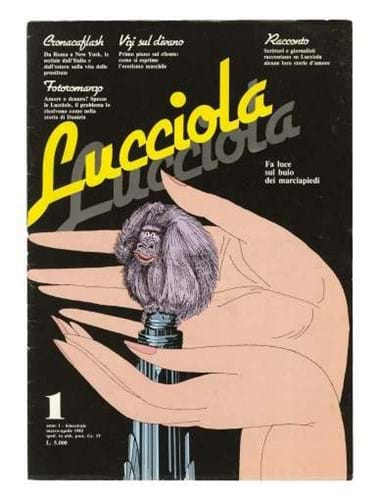
The first journal to address the problems of prostitution from the point of view of prostitutes themselves, 'Lucciola' was short-lived for legal and financial reasons. Published in 1985, it featured a photo-novel designed to teach sex workers their rights; the first episode starred the editors in the role of two prostitutes, since they did not have the budget for real actors. Priced at £250 by Quaritch.
Sally Deegan, who assembled the catalogue, notes that ephemeral works like this appeal particularly to institutions. So while many special collections libraries have a copy of A Vindication of the Rights of Woman, “not everyone has a copy of a weird work on 20th century prostitutes in Italy. Ephemera fleshes out institutional collections in interesting ways and gives context to better-known works of literature.”
Last year’s centenary of Votes for Women brought Suffragette items back onto the market – much of it witty and visually appealing, from Panko… The Great Card Game to Pank-a-Squith, the Suffrage movement’s answer to Whack-a-Mole. A complete example of the latter was priced at £7500 at Peter Harrington’s In Her Own Words exhibition.
Post-war women’s campaigns, calling for an end to Apartheid, sexism, and restrictions on abortion, have an even greater graphic immediacy that resonates with younger buyers. These posters, flyers and bumper stickers could almost have been made with Instagram in mind.
In short, as the trend towards quirkier ‘lesser-spotted’ material continues, there is still room for growth in this market.
Jane Austen took off again the moment Colin Firth got his shirt wet. End of
Glass ceiling
Astonishingly few female novelists and poets routinely break into the five-figure range at auction. In the 19th century, we find Jane Austen, Mary Shelley, Charlotte and Emily Brontë, George Eliot and Harriet Beecher Stowe.
Some of the highest auction records for the 19th century writers have stood for a decade. Austen’s peak was in 2008, when a presentation copy of Emma inscribed by her publisher and the recipient Anne Sharp sold for £150,000 at Bonhams.
More recently in the same rooms, a very original copy of Pride and Prejudice in red half roan fetched £39,000.
It is impossible to talk about the current market history without reference to Hollywood and myriad modern screen adaptions. “Jane Austen took off again the moment Colin Firth got his shirt wet. End of,” says Pom Harrington.
Mary Shelley’s Frankenstein, which she began as an 18-year-old on a stormy night in June 1816 at the Villa Diodati by Lake Geneva, has appeared in more than 50 films over the last century. The auction record for a copy of the 1818 first edition is almost a decade old (£95,000 at Sotheby’s in 2010) but others have sold for much more within the book trade. The now-famous presentation copy inscribed to Lord Byron was sold in late 2012 for upwards of £350,000 by Peter Harrington, where another first in original boards is currently priced at £275,000.
The Brontë sisters peaked around 2011-12, with Wuthering Heights making a double-estimate £200,000 and Jane Eyre hitting £55,000. More recently, in 2017 Forum achieved £65,000 for a mixed set of the former; the third volume, which contains Anne Brontë’s Agnes Grey, was in modern half calf. Collectors always favour original bindings, of course: George Eliot’s Middlemarch in publisher’s wrappers hit $65,000 at Christie’s in 2017.
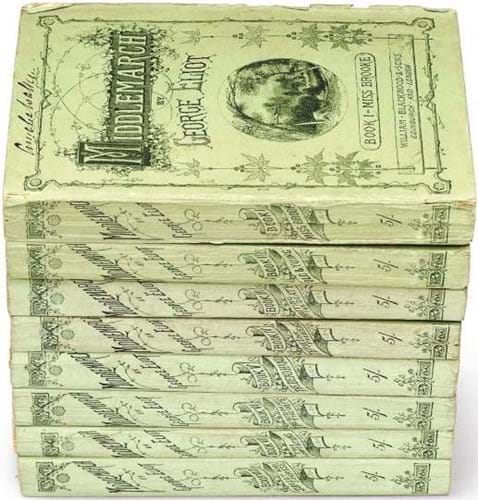
Described as “magnificent” by Virginia Woolf, George Eliot’s 'Middlemarch' appeared, at the author’s own suggestion, in eight parts issued every two months starting in December 1871. The novel cemented Eliot’s reputation. This copy in wrappers sold for $65,000 at Christie’s in 2017.
Bids for women
Beyond literature, the rare book world increasingly reflects women’s contributions to mathematics, exploration, medicine, botany, economics, art and politics. The highest-priced item in Peter Harrington’s In her Own Words is not Woolf’s presentation copy of Jacob’s Room, but Ada Lovelace’s study of the Babbage Analytical Engine, including a folding table often described as the first computer programme (£200,000).
In the field of natural history, a similar sum may be required, at retail at least, to own a good copy of Maria Sibylla Merian’s Metamorphosis insectorum Surinamensiam, the entomological landmark that emerged from the author’s trip with her daughter to South America in 1699. The 20th century landscape is quite different: two of the biggest-ticket works by women were written for children at each end of the century and are linked by the name Potter. In December 1901, Beatrix Potter published The Tale of Peter Rabbit at her own expense. The auction records for this edition, her most valuable book, have stood around the £50,000 level for nearly two decades. Jonkers Rare Books in Henley-on-Thames is asking £35,000 for “an attractive clean copy”.
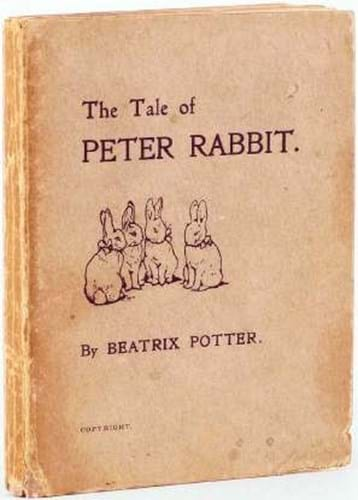
The manuscript of Beatrix Potter’s 'Peter Rabbit' was rejected by six publishers. Undeterred, she published it herself in December 1901, and sold out of the first 250 copies within a fortnight. Frederick Warne did a U-turn and gave her a contract. This copy, one of the first 250, is with Jonkers Rare Books at £35,000.
The other Potter is, of course, Harry – JK Rowling’s phenomenal magician who first appeared in 1997. The record, excepting a heavily-annotated copy sold for charity, was set in December by Christie’s at $130,000 (£102,000) for a signed copy of Harry Potter and the Philosopher’s Stone. Unsigned and uninscribed, strong prices hover around half that level.
Peter Harrington’s 50th anniversary catalogue included a dedication copy of Harry Potter and the Goblet of Fire inscribed by ‘Jo’ to her friend Susan Sladden ‘who helped Harry out of his cupboard’ (£75,000).
Seminal works by American women writers often make big numbers, led by the likes of Margaret Mitchell’s Gone with the Wind and Harper Lee’s To Kill a Mockingbird – a classic film and a high school set text respectively. Last year the bar was raised by Sylvia Plath, when her own copy of The Bell Jar hit £70,000 at Bonhams, and her uncorrected proof £60,000. Prior to that, Plath’s record was the copy of The Colossus that she inscribed to her English teacher four days before publication: $30,000 at the 2002 Rechler sale held by Christie’s, and £14,000 when it reappeared at Sotheby’s in 2009.
British women writers can be more affordable. In Maggs’ Virginia Woolf catalogue last year, two thirds of the 44 items were priced below £1000. They are offering her last, brilliant work Between the Acts for a mere £450. The Second Shelf, meanwhile, has Vanessa Bell’s tattered copy of her sister’s first book, The Voyage Out, found recently in France and priced at £9500.
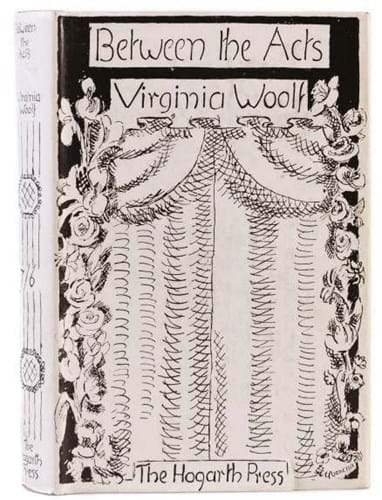
'Between the Acts' was Virginia Woolf’s final novel, which she was still working on during the last few weeks of her life. It was published posthumously by her husband Leonard and has a characteristic dustjacket by her sister Vanessa. Maggs Bros has this fine first edition at £450.
Devers finds female collectors can be less pernickety about condition than their male counterparts. “Condition can be important to libraries and institutions, and a certain kind of modern first edition collector, but women value the history of an object and the fact it has been loved and read. When a book has been loved, and read, and worn, in a way that suggests it has been appreciated, it doesn’t hurt the value.”
What is remarkable is that so many important women writers remain so obtainable: Daphne du Maurier may be in the mid-thousands, but Toni Morrison, Iris Murdoch, Joan Didion, Doris Lessing, Angela Carter and Margaret Atwood are in the hundreds or even tens. Prices surely cannot stay at these levels.
Matthew Haley is Head of Books and Manuscripts at Bonhams.

